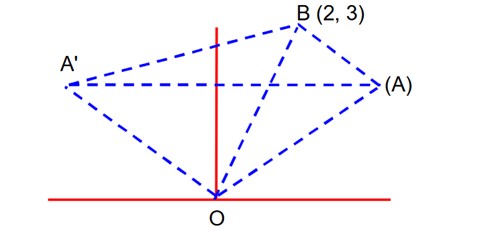A line passes through the origin and makes equal angles with the positive coordinate axes. It intersects the lines L₁: 2x + y + 6 = 0 and L₂: 4x + 2y - p = 0, p > 0, at the points A and B, respectively. If AB = 9/√2 and the foot of the perpendicular from the point A on the line L₂ is M, then AM/BM is equal to
A line passes through the origin and makes equal angles with the positive coordinate axes. It intersects the lines L₁: 2x + y + 6 = 0 and L₂: 4x + 2y - p = 0, p > 0, at the points A and B, respectively. If AB = 9/√2 and the foot of the perpendicular from the point A on the line L₂ is M, then AM/BM is equal to
Option 1 -
5
Option 2 -
4
Option 3 -
2
Option 4 -
3
Similar Questions for you
Let A, A’ be (, 2) AB and A’B subtends angle at (0, 0) slope of OA =
slope of OB =
now distance between A’A, (10, 2) &
Slope of AH = slope of BC =
slope of HC =
slope of BC × slope of HC = -1 p = 3 or 5
hence p = 3 is only possible value.
Let point P : (h, k)
Therefore according to question,
locus of P (h, k) is
Now intersection with x – axis are
Now intersection with y – axis are
Therefore are of the quadrilateral ABCD is =
Let equation of normal to x2 = y at Q (t, t2) is x + 2ty = t + 2t3
It passes through the point (1, -1) so, 2t3 + 3t – 1 = 0
Let f(t) = 2t3 + 3t – 1 f
Let P(1 – sin q, -1 + cos q) slope of normal = slope of CP Þ = tan q according to question ,
Þ g’(t) < 0 Þ g(t) is decreasing function in
Taking an Exam? Selecting a College?
Get authentic answers from experts, students and alumni that you won't find anywhere else
Sign Up on ShikshaOn Shiksha, get access to
- 65k Colleges
- 1.2k Exams
- 679k Reviews
- 1800k Answers
